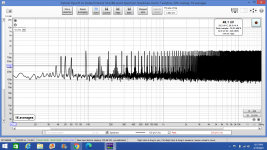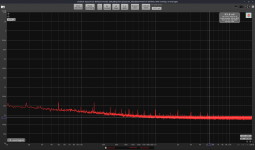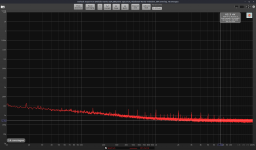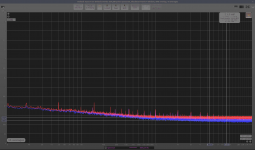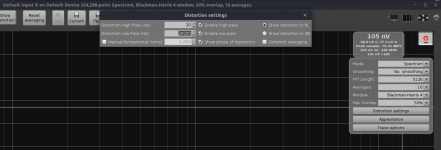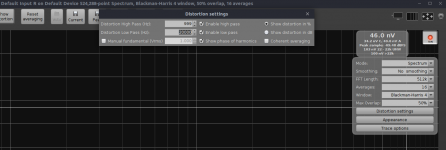Thank you for the confirmation of actual ZTX performance. What you, jackinny, Scott Wurcer or syn08 say on matter of LNAs and noise is “good as gold”.
So, 375 pV/rtHZ is possible with 3 ZTX851, but we have no explanation for weird numbers in the measurement screenshots and jet have to confirm by proper measurement that low noise floor. Low input impedance shouldn’t be an issue as LNA is used to measure power supplies.
So, 375 pV/rtHZ is possible with 3 ZTX851, but we have no explanation for weird numbers in the measurement screenshots and jet have to confirm by proper measurement that low noise floor. Low input impedance shouldn’t be an issue as LNA is used to measure power supplies.
IME noise measurements in the frequencies below 400hz (maybe 10hz-200hz) are very important regarding power supplies. That is where the layout or decoupling issues will be most apparent.
Looking at my measurements, does the 10Hz to 200 Hz look flat. It does to me, but the line and fundamentals would need to be tamed, fixed with battery power.
Your measurements displays from 20hz upwards. Could you do another measurement with LNA input shorted displaying from 10hz to 20kHz, 16 averages, no smoothing, 256k or 512k FFT length.
Last edited:
Note that spurs i.e. discrete carriers scale differently than noise when
you change FFT size.
I have to revise my statement (and opinion on REW) that REW software has included proper FFT scaling in respect to the noise power of various bin widths. I was checking with pure noise signal, but as noise is uncorrelated signal, no change was apparent. Using signal generator with sine output and changing fft length, produced very different outcome. At 96 kHz rate and specified fft lenghts I got the following levels:
32 k -29.71 dBV
64 k -32.56 dBV
128 k -35.32 dBV
256 k -38 dBV
512 k -40.82 dBV
This drop in level is consistent with decreasing bin width and noise power that one bin contains.
Various window types produced also differences in range of 1 – 4 dB.
Someone should check with ARTA does it behave the same.
It seems that is best to have 1 Hz bin width if possible (i.e. 96 kHz rate with 96 k length). But, I think it is all OK if you calibrate for any settings and then don’t change fft length or widow type while taking measurements.
A carrier will always stay completely in its bin and will not grow less if
you reduce the bin size, at least in concept. The window function may
smear however some energy to adjacent bins so that the peak becomes less.
My 89441A FFT analyzer cannot do a logarithmic FFT from 0.1Hz to 1 MHz in one piece,
so I make a FFT to 1 Hz, 10 Hz, 100Hz,..,1MHz and combine the results with gnuplot.
I must scale the results down by 10 dB for each higher decade for the 10 times
higher bin width or I get steps of the noise in the final plot. But a carrier at
500 KHz is then drawn much smaller than a 50 Hz one with the same absolute amplitude.
For true carriers, the downscaling should be selectively undone.
Gerhard
you reduce the bin size, at least in concept. The window function may
smear however some energy to adjacent bins so that the peak becomes less.
My 89441A FFT analyzer cannot do a logarithmic FFT from 0.1Hz to 1 MHz in one piece,
so I make a FFT to 1 Hz, 10 Hz, 100Hz,..,1MHz and combine the results with gnuplot.
I must scale the results down by 10 dB for each higher decade for the 10 times
higher bin width or I get steps of the noise in the final plot. But a carrier at
500 KHz is then drawn much smaller than a 50 Hz one with the same absolute amplitude.
For true carriers, the downscaling should be selectively undone.
Gerhard
Last edited:
I did the 3dB calibration, and I got a 3dB increase in the noisefloor level with a 19R resistor. I used the 10kHz-20kHz spectrum as that's clean for my ADC.
19R means around 0.55nV/√Hz. So recalibrating so that my noisefloor is at that level means my REW calibration value changed from 1.47V that REW calibration found to 1.67V.
Using this value (1.67mV for x1000 gain) makes it that measuring a 19R resistor the noisefloor moves from 0.55nV/√Hz to 0.78nV/√Hz.
A 60R resistor now measures around 1.13nV/√Hz and the 204R resistor measures around 1.98nV/√Hz. I'm not sure how accurate it is now, but I also tried a 1Vrms input into the ADC and both REW and ARTA show -0.4dBV meaning 0.955V. So I guess the LNA has about 60.4dB gain. I set the ARTA calibration value to 2362mV which is Vp of 1.67Vrms.
I again measured the positive feedback discrete supply with MPSA06/MPSA56 and BC817/BC807 for de/dienoiser circuit. I also remeasured the LM317N supply with MPSAx6/BC8x7 and 2N440x.
The results have noise density value and PSRR:
discrete denoiser:
MPSAx6: 840pV/√Hz / 124.5dB
BC8x7: 840pV/√Hz / 125.5dB
discrete dienoiser:
MPSAx6: 956pV/√Hz / 152.6dB
BC8x7: 957pV/√Hz / 146.1dB
LM317N denoiser:
MPSAx6: 8nV/√Hz / 111.5dB
2N440x: 8nV/√Hz / 111dB
BC8x7: 7nV/√Hz / 112.8dB
LM317N dienoiser:
MPSAx6: 1.37nV/√Hz / 136,7dB
2N440x: 1.39nV/√Hz / 136dB
BC8x7: 1.34nV/√Hz / 137,3dB
I used 220uF after the bridge for a higher measurement dynamic range. Input ripple is 0.4dB higher than measurement, I included this offset in the PSRR calculations. So input ripple was in reality at around -1.2dBV.
One interesting thing I noticed is that the discrete +de/dienoiser have a higher PSRR with MPSAx6 than with BC8x7. This doesn't seem to be the case for the LM317N+de/dienoiser. For LM317N the BC8x7 pair gave the best noise and PSRR results.
LTSpice sim doesn't show the PSRR difference for the discrete supply, but with MPSAx6 it's closer to the predicted 156dB PSRR.
These latest measurements show about 150pV/√Hz extra for noise measurement vs the ones I last posted. Even so take these results with a grain of salt as absolute values, my ADC is not up to par, it's more of a general indicative of what to expect.
Photos in order:
1. shorted LNA input
2. 19R measurement
3. 60R measurement
4. 204R measurement.
I put archives with the measurements for PSRR and noise for each.
edit: the supplies noise I measured also contain my LNA's noise which should be around 0.55nV/√Hz. How would I subtract it from the total noise I measured for each?
19R means around 0.55nV/√Hz. So recalibrating so that my noisefloor is at that level means my REW calibration value changed from 1.47V that REW calibration found to 1.67V.
Using this value (1.67mV for x1000 gain) makes it that measuring a 19R resistor the noisefloor moves from 0.55nV/√Hz to 0.78nV/√Hz.
A 60R resistor now measures around 1.13nV/√Hz and the 204R resistor measures around 1.98nV/√Hz. I'm not sure how accurate it is now, but I also tried a 1Vrms input into the ADC and both REW and ARTA show -0.4dBV meaning 0.955V. So I guess the LNA has about 60.4dB gain. I set the ARTA calibration value to 2362mV which is Vp of 1.67Vrms.
I again measured the positive feedback discrete supply with MPSA06/MPSA56 and BC817/BC807 for de/dienoiser circuit. I also remeasured the LM317N supply with MPSAx6/BC8x7 and 2N440x.
The results have noise density value and PSRR:
discrete denoiser:
MPSAx6: 840pV/√Hz / 124.5dB
BC8x7: 840pV/√Hz / 125.5dB
discrete dienoiser:
MPSAx6: 956pV/√Hz / 152.6dB
BC8x7: 957pV/√Hz / 146.1dB
LM317N denoiser:
MPSAx6: 8nV/√Hz / 111.5dB
2N440x: 8nV/√Hz / 111dB
BC8x7: 7nV/√Hz / 112.8dB
LM317N dienoiser:
MPSAx6: 1.37nV/√Hz / 136,7dB
2N440x: 1.39nV/√Hz / 136dB
BC8x7: 1.34nV/√Hz / 137,3dB
I used 220uF after the bridge for a higher measurement dynamic range. Input ripple is 0.4dB higher than measurement, I included this offset in the PSRR calculations. So input ripple was in reality at around -1.2dBV.
One interesting thing I noticed is that the discrete +de/dienoiser have a higher PSRR with MPSAx6 than with BC8x7. This doesn't seem to be the case for the LM317N+de/dienoiser. For LM317N the BC8x7 pair gave the best noise and PSRR results.
LTSpice sim doesn't show the PSRR difference for the discrete supply, but with MPSAx6 it's closer to the predicted 156dB PSRR.
These latest measurements show about 150pV/√Hz extra for noise measurement vs the ones I last posted. Even so take these results with a grain of salt as absolute values, my ADC is not up to par, it's more of a general indicative of what to expect.
Photos in order:
1. shorted LNA input
2. 19R measurement
3. 60R measurement
4. 204R measurement.
I put archives with the measurements for PSRR and noise for each.
edit: the supplies noise I measured also contain my LNA's noise which should be around 0.55nV/√Hz. How would I subtract it from the total noise I measured for each?
Attachments
-
 shorted_input.png65 KB · Views: 220
shorted_input.png65 KB · Views: 220 -
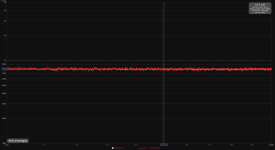 19R.png68.2 KB · Views: 217
19R.png68.2 KB · Views: 217 -
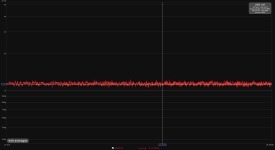 60R.png65.1 KB · Views: 204
60R.png65.1 KB · Views: 204 -
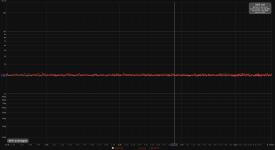 204R.png94.8 KB · Views: 181
204R.png94.8 KB · Views: 181 -
LM317N_BC8x7.zip248.6 KB · Views: 87
-
LM317N_MPSAx6.zip260.9 KB · Views: 89
-
LM317N_2N440x.zip262.7 KB · Views: 84
-
discrete_BC8x7.zip244.4 KB · Views: 101
-
discrete_MPSAx6.zip245.6 KB · Views: 82
Last edited:
When the noise levels of the measurement instrument and DUT are proximate, RMS'ing doesn;t help.
Looks good to me.
View attachment 932594
This does not appear to be a measurement of your LNA with input shorted as the noise level is much lower and the shape of the curve does not match your previous measurements. Either your LNA was switched off or you were measuring just the soundcard.
I did the 3dB calibration, .......
How would I subtract it from the total noise I measured for each?
This looks as perfectly OK calibration and all numbers hold. I have no afterthoughts on numbers you have published. I think you have now better than 5% accuracy and it is hard to get any better than that in our diy hobby.
Actual DUT noise can be calculated from total noise by the following equation:
Noise DUT = sqrt (Total_noise^2 - LNA_noise^2)
^ symbol represent squared value
LM317 + BC817 is measured as 1.34nV/√Hz
Noise DUT = sqrt (1.34^2 – 0.55^2)
Noise DUT = sqrt (1.8– 0.3)
Noise DUT = 1.22 nV/rtHz
For the discrete regulator with MPSAx6 and 840pV, same math result is 637 pV/rtHz actual regulator noise.
I did the 3dB calibration, and I got a 3dB increase in the noisefloor level with a 19R resistor. I used the 10kHz-20kHz spectrum as that's clean for my ADC.
19R means around 0.55nV/√Hz.
The problem with both RickRay's and your measurements is the total noise which is higher than what your estimated noisefloor predicts. In your case the total noise is less than half of what RickRay had but still based on the total noise your LNA is comparable to a 40 ohm resistor which corresponds to 0.8nV/rtHz. Due to the high LNA noise a very lengthy averaging is required to eek out a "noisefloor" but at least in RickRay's case the "noisefloor" looked suspicious. You haven't shown LNA noise from 10Hz to 20kHz so difficult to tell if your noisefloor looks more sensible.
Unless the LNA (or ADC) noise is toned down the noisefloor estimations are quite irrelevant. RickRay's LNA has a noise limit at 270nV. Your LNA seems to have a limit at 112nV. Basically you cannot reliably measure noise that is well below those limits. You can of course make relative comparisons between DUTs at some limited bandwidth but based on that you cannot tell which DUT has the lowest noise within audio bandwidth.
It was like that before with his measurements, but last calibration and 19 Ω & 204 Ω checkpoint measurements are corresponding to the 550 nV/rtHz LNA’s noise floor with small tolerance.
Though, RickRay’s measurement are still in "The twilight zone”.
As for the ADCs, it is enough that they have noise floor several times lower than LNA’s output noise. With 60 dB gain, 0.5 nV/rtHz input noise density is shifted to the 500 nV/rtHz at the LNA output. At half of available gain (usual position needed) Focurite (which RickRay and me both use) has noise floor of 70 nv/rtHz at line-in. That affects total noise by less than 1%.
Though, RickRay’s measurement are still in "The twilight zone”.
As for the ADCs, it is enough that they have noise floor several times lower than LNA’s output noise. With 60 dB gain, 0.5 nV/rtHz input noise density is shifted to the 500 nV/rtHz at the LNA output. At half of available gain (usual position needed) Focurite (which RickRay and me both use) has noise floor of 70 nv/rtHz at line-in. That affects total noise by less than 1%.
I attached the same measurement that you asked RickRay to do for the first picture, the second one is with the same conditions but ADC input shorted. I didn't change the multiplier for the shorted ADC input.
Clearly my ADC is not clean on the lower frequencies, hence I can only trust whatever is from 10kHz-20kHz.
Thanks for sharing the valuable info!
Clearly my ADC is not clean on the lower frequencies, hence I can only trust whatever is from 10kHz-20kHz.
Thanks for sharing the valuable info!
Attachments
I think REW is always calculating the total noise of the 20Hz-20kHz spectrum. I don't think zooming into it changes that. Even if looking at 10kHz-20kHz it still shows the value for the total noise. Or am I wrong?
That might explain the numbers that REW is showing in the upper right.
If so, any way of making it consider just what is shown on the screen, while zooming on a certain range?
That might explain the numbers that REW is showing in the upper right.
If so, any way of making it consider just what is shown on the screen, while zooming on a certain range?
I made an overlay between the shorted ADC (blue trace) and shorted LNA graphs. At these low levels a crap ADC doesn't do it.
Attachments
Last edited:
Yes I think the upper right value depends on the limits set in the settings. I see that the upper limit for the low end is 999Hz. Changing from 20Hz to 999Hz reduces the upper right shown value.
So ideally I'd change it to 10kHz so I can measure just for 10kHz-20kHz but that doesn't seem possible. The upper limit for the high pass filter is 999Hz.
So ideally I'd change it to 10kHz so I can measure just for 10kHz-20kHz but that doesn't seem possible. The upper limit for the high pass filter is 999Hz.
Attachments
Stuck on FFT?
When it comes to listening experience it's not as useful as an analog measurement with ITU-R468 weighted filter, specialized detector and average or quasi-peak measurement. Humans are most sensitive to noise ~6.3kHz and don't even notice "noise" in the low tens of Hertz.
Good for us, it's relatively easy to build a discrete low noise amplifier if you're not too worried about device 1/f noise with a 100 Hertz "knee".
When it comes to listening experience it's not as useful as an analog measurement with ITU-R468 weighted filter, specialized detector and average or quasi-peak measurement. Humans are most sensitive to noise ~6.3kHz and don't even notice "noise" in the low tens of Hertz.
Good for us, it's relatively easy to build a discrete low noise amplifier if you're not too worried about device 1/f noise with a 100 Hertz "knee".
I attached the same measurement that you asked RickRay to do for the first picture, the second one is with the same conditions but ADC input shorted. I didn't change the multiplier for the shorted ADC input.
Clearly my ADC is not clean on the lower frequencies, hence I can only trust whatever is from 10kHz-20kHz.
These measurements look better and the total noise in the first one is now closer to the apparent noise floor at 5.39kHz. The second measurement reveals quite clearly that your ADC is not up to the task below 1kHz.
Stuck on FFT?
When it comes to listening experience it's not as useful as an analog measurement with ITU-R468 weighted filter, specialized detector and average or quasi-peak measurement. Humans are most sensitive to noise ~6.3kHz and don't even notice "noise" in the low tens of Hertz.
Good for us, it's relatively easy to build a discrete low noise amplifier if you're not too worried about device 1/f noise with a 100 Hertz "knee".
For me this is not related to listening experience. The noise levels discussed here are well below what could be considered audible. Even the basic LM317+Cadj is perfectly fine for most opamp related stuff. My interest in these measurements is just to validate a design. The power supply noise profile especially below 1kHz can reveal issues with e.g. layout or decoupling.
For me this is not related to listening experience. The noise levels discussed here are well below what could be considered audible. Even the basic LM317+Cadj is perfectly fine for most opamp related stuff. My interest in these measurements is just to validate a design. The power supply noise profile especially below 1kHz can reveal issues with e.g. layout or decoupling.
You will hear the noise in a discrete MC pre-pre.
And, as I have demonstrated previously, the LM317+Cadj will smear transients -- you can actually measure it.
Some fella has taken the article I wrote for AudioXpress eons ago and claimed it as his work. Since AX was acquired by CircuitCeller the original article isn't on their site: The Noise (Analysis) Machine -- a method to perform accurate noise measurements
- Home
- Amplifiers
- Power Supplies
- Measurement data and techniques for Elvee's De-Noizator: all implementations
